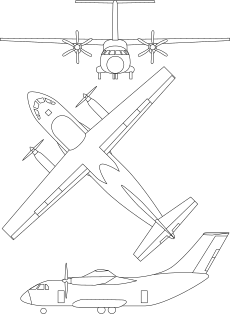Il-112
Summary
| Category | Military Transport Aircraft |
| Origin country | 🇷🇺 Russia |
| Manufacturer | Ilyushin |
| First flight | 30 March 2019 |
| Year introduced | 2023 |
| Number produced | 3 units |
Description
Work on the Il-112 project began in 1994, envisioning both civil and military applications, including a 40-seat airliner and cargo variants designed with a rear loading ramp as a replacement for the Antonov An-26. The project was publicly announced at the 1995 Paris Air Show with the unveiling of a model. The military transport version, designated Il-112V, was entered into a Russian Ministry of Defence competition to supersede the Antonov An-26, Yakovlev Yak-40, and Let L-410 in Russian service; it was evaluated against designs from Sukhoi (the Su-80) and Mikoyan (the MiG-110). Full development of the Il-112 was ordered on April 8, 2003, with plans for the type to enter service by 2008. The aircraft was initially required to carry a 6,000 kg cargo over a distance of 3,000 km. By 2004, market estimates projected potential sales of up to 120 aircraft to the Russian military and another 120 for civil use. However, in May 2010, with development funds exhausted and without a prototype, the Russian Defence Ministry cancelled the development contract. Despite this setback, in January 2013, the Russian Air Force advocated for the project's resumption, leading to a new contract signed on November 14, 2014, with significantly reduced performance requirements, specifying a cargo capacity of 5,000 kg over 1,200 km. Later, in July 2023, the project was reported to be redesigned and renamed as the Ilyushin Il-212.
The Ilyushin Il-112V was designed with the intention of operating in adverse weather conditions while adhering to ICAO noise and emissions standards. It shares similar dimensions and weight characteristics with the An-26, but features a larger cabin cross-section, accommodating up to 44 armed soldiers, compared to the An-26's capacity of 38. Fuel efficiency was a key consideration, with the Il-112 boasting a 38% reduction in specific fuel consumption and twice the ferry range at 5,200 km (2,808 nm). Modern avionics allowed for a reduced crew size of two, compared to the six crew members required for previous-generation aircraft. The Il-112V's avionics combine the entire equipment complexes and systems into an integrated onboard system, presenting all necessary aviation and systems operation information on six LCD monitors in a digital cockpit. The initial Il-112V prototype featured two Klimov TV7-117ST turboprop engines, each producing 2,610 kW (3,500 hp) and driving six-bladed AV-112 constant-speed reversible pitch propellers, along with a monolithic, single-piece wing. The aircraft's dimensions included a length of 25.15 m, a height of 8.89 m, and a wingspan of 27.6 m. The re-designed Il-212 will retain the fuselage, onboard equipment, and avionics, but will incorporate Russian-made PD-8 turbojet engines, updated landing gear, and new fuel and hydraulic systems. It is designed for air landing and airdrop of military air cargoes, equipment, and personnel and was designed to carry a cargo of 5,000 to 6,000 kg (11,000 to 13,000 lb).
The operational history of the Il-112V is brief due to its troubled development and the subsequent redesign into the Il-212. The first prototype, intended for performance and flight handling trials, was rolled out in November 2018 and began taxi trials by the end of the same year. Its maiden flight occurred on March 30, 2019, after which it was grounded for modifications aimed at reducing its weight. Further flight testing was delayed due to runway repairs and did not resume until March 30, 2021. The only flying prototype crashed on August 17, 2021, near Kubinka Airfield due to an engine fire, resulting in the deaths of all three crew members. This accident, combined with ongoing developmental challenges, led to the program's restructuring and eventual transition to the Il-212 variant. Planned deliveries of prototype aircraft to the Russian Defence Ministry in 2021, and the introduction of serial production units into the Russian Aerospace Forces by 2023 never materialized.
Main Variants:
-
Il-112V: This was the military variant of the aircraft, ultimately cancelled.
-
Il-112T: This was to be the civil variant, but the project was also cancelled.
-
Il-212: This is the new variant of the aircraft, featuring PD-8 jet engines, an updated landing gear, and new fuel and hydraulic systems.
Technical specifications
| Version: Il-112V | |
|---|---|
| Maximum speed | 580 km/h (360 mph) |
| Wing area | 65 m² (699.7 sqft) |
| Wingspan | 27.6 m (90.6 ft) |
| Height | 8.9 m (29.2 ft) |
| Length | 24.2 m (79.2 ft) |
| Service ceiling | 7,600 m (24,934 ft) |
| Empty weight | 10,000 kg (22,046 lbs) |
| Max. takeoff weight | 21,000 kg (46,297 lbs) |
| Powerplant | 2 x turboprops Klimov TV7-117ST delivering 2610 kW each |
Current operating countries
| Country | Units | ||
|---|---|---|---|

|
Russia | 0 (+62) | |
All operators
